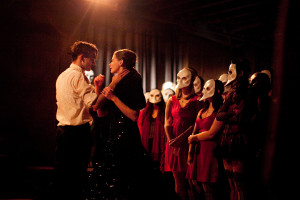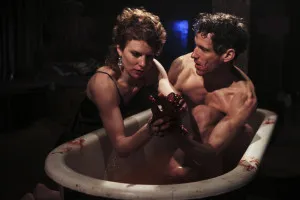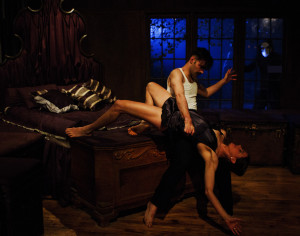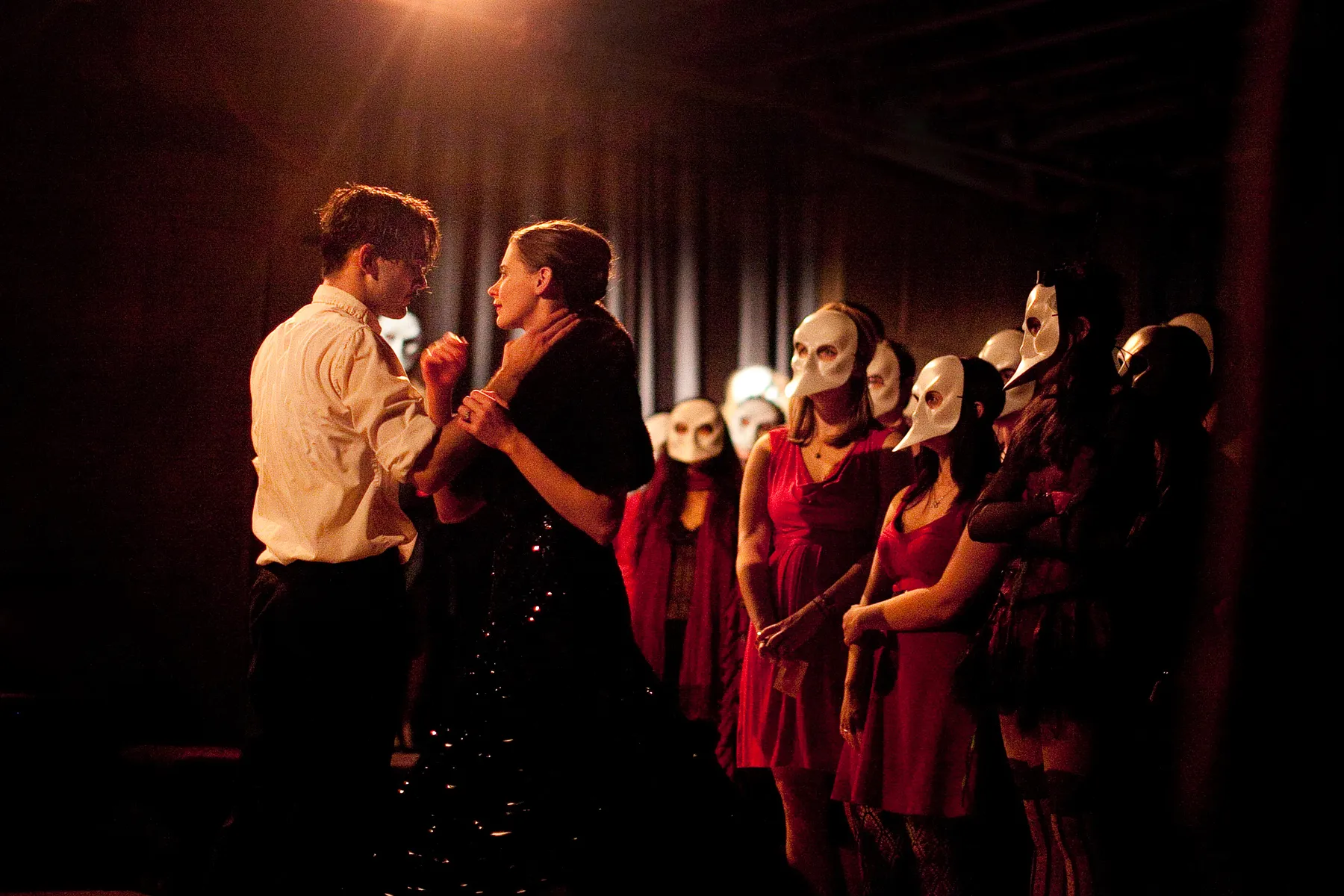
Chances are, you’ll leave “Sleep No More” at least a little dissatisfied and frustrated — it’s designed that way, to get you to come back — but it would be hard to deny that it’s anything but intoxicating. Part immersive theater, part installation art, this Off-Broadway production produced by the British company, Punchdrunk, began its run in New York in 2011, and it’s still running, often to sold-out shows. Spanning six stories of the complex called the McKittrick Hotel in Chelsea, you spend about three hours — or less, if you’re as unlucky as I was to be pulled out of it too soon — exploring an extremely elaborate set and following actors, racing from one room to the next, as they act out a story very loosely based on Shakespeare’s “Macbeth.”
Upon arriving at the McKittrick, and after checking all coats and bags, you’re sent down a twisting, barely lit hallway, until you reach the lounge where drinks are served and several bands will eventually play. From there, you’re handed a white mask and ushered into an elevator to be taken up to the top floor of the complex — that is, of course, assuming you aren’t the last one into the elevator, for that person is first deposited, alone, on a lower floor. The rules are laid out by a flirtatious guide: you’re free to explore, but you are not to utter a sound while you do it. Then, it begins.
I began by wandering the floor I’d been deposited on. There, I found a room with several empty bathtubs where a nurse was laying out wet shirts as if they were being worn by men sitting in the tubs. I also wandered through a maze of blue Christmas trees and found a series of small rooms with couches, desks and books. The level of detail that goes into dressing each room is impressive, and each room feels lived in. Often, the lounge-like rooms were accompanied by a jazz-age soundtrack, crackling like an old, scratched record.
Before arriving at “Sleep No More,” I had been advised by a friend who had attended years ago that to get the most out of the experience, you should follow the actors. It’s easy enough to spend all your time exploring the elaborate 1920s-style sets, but you’ll miss out if you don’t see any of the story acted out. Following this advice, I made my way downstairs, finding a room with a single bathtub — where I had been told blood would be spilled at some point — as well as a padded room, an apothecary shop, a bedroom where a couple cuddled and fought, and a doctor’s office.
I saw fragments of action I didn’t understand, including a very pregnant woman in a spotlight, reaching out in tears and pain, toward a disappearing man at the other end of the hallway. I later discovered this was Lady MacDuff and that she didn’t start the show pregnant. (I, however, never saw her in any other form.) I wandered through a dark, labyrinthine room with a dirt-covered floor, where an actor was standing in tableau, and where I suspected the witches, whom I never saw, would eventually make their incantations.

Along the way, I caught glimpses of action that never felt part of a cohesive whole. In a sawdust-filled room with a bar, a pool table and a small wooden table surrounded by stools, a man mixed drinks, played cards and was eventually joined by a woman and a violent madman. At one point, one of the ushers in black backed the group of about 40 of us up against a wall so that the men could spar.
Because there is no dialogue, everything has to be physicalized. Whether we’re watching seduction or violence — and in this show, there’s a thin line between the two — it all unfolds in a kind of dance, graceful and mesmerizing.
When the action slowed, or I got tired of not being able to see anything since I made the mistake of being polite and short — you have to aggressively elbow other people out of the way, for fellow patrons form crowds and swarms, eagerly blocking your view — I would occasionally venture out into the hallway. I once found another actor there, alone, psyching himself up, in character, to enter the bar, and I followed him in for a confrontation. The action never stops at “Sleep No More,” and if you do it right, you’ll end up with a glimpse at action that usually happens off-stage.
I spent most of my time on the bottom floor, more because I was lost than because I had chosen to be there. There, I saw the only cohesive bit of story unfold, in part because I chose to stay and rest in the room with the piano and lounge chairs. I started by following, alone, a maid wandering the halls by herself; it was the rare occasion when I wasn’t surrounded by other masked patrons. She built up a bed of pillows in a low-ceilinged room. I followed her from there to the piano room, where she was joined by a woman in a sparkly dress. Together, they poured a drink of scotch, which they slipped something into that I assumed was poison. They left to join a dance downstairs, while I stayed and watched from afar. The woman in the sparkly dress then returned with a man. They danced and caressed while I waited for him to drink the poisoned drink.
The woman poured herself a drink, and then handed the man the drink I saw her prepare earlier. By this point, the room was full of other masked patrons who had followed the actors back, but I was the only one that could have known the man’s drink had been spiked because I was the only one who saw it happen. The woman slipped out — if you can call the incredibly fast pace with which the actors move from one room to the next that. It’s fast enough to lose you, if you’re not thinking and moving quickly. I stuck around to watch the man die, but he wouldn’t die! He went mad, prostrating himself in the adjacent chapel, throwing things in anger and smashing about the room.
Eventually, he headed towards the bed of pillows where he lay down to rest. I thought for sure the poison would take its course here, but still he wouldn’t die! Finally, another man showed up, grabbed one of the pillows and suffocated him. Who were each of these characters? And what did they have to do with Shakespeare’s “Macbeth”? I couldn’t even guess. I had no idea how this fit into the larger story being told, which was frustrating throughout. But watching all of these events unfold, as people entered and exited the room, was thrilling.

The more I talk to others who have also seen “Sleep No More,” the more dissatisfied I am with my experience. I never saw the witches or their cauldrons. I never figured out who any of the characters were. I didn’t see any of the nudity, or much of the serious fighting. I never found my way behind closed doors with an actor, where I hear people get pulled in for 20 mysterious minutes. I didn’t get to glimpse any of the key scenes from “Macbeth” or see any blood let. I missed all the action that happened on the top four floors because I left them too early and then found myself trapped on the bottom floor, unable to find my way up. I had planned to check out all the floors first so that I could then decide how to divide my time, but I found myself without the luxury of making such choices.
I was told the entire play repeats at least twice throughout the night, but I never even had the chance to see the story unfold once from start to finish. And I got stuck at the banquet from which there is no coming back for almost two hours before the show officially ended. I even missed half of the dramatic banquet, catching only the end when dramatic green lights flashed on and off, as a man was hung.
Of course, it’s not possible to see everything at “Sleep No More,” and that’s the point. Events happen simultaneously, and without a stage to narrow your focus, you necessarily have to miss things. You could spend your time only exploring the set, treating the experience as an elaborate piece of installation art, and miss even more than I did. But this dissatisfaction is also frustratingly part of the show’s business model: they want you to leave feeling like you missed out, so you’ll return and fork over another $100 for the chance to do it over. We’re told at the beginning that there’s no one way, or correct way, to make your way through the McKittrick hotel. But given just how much I know I missed, I can’t help but feel I didn’t do it right. Nevertheless, I’ve spent hours comparing experiences with friends, and I never grow tired of talking about the show. It’s unlike anything else you’ve ever seen, and it has to be experienced.
